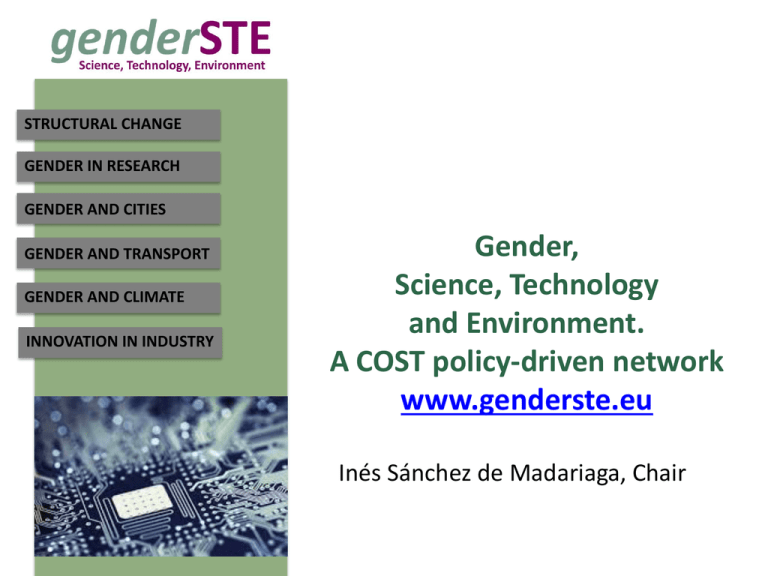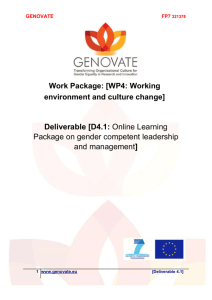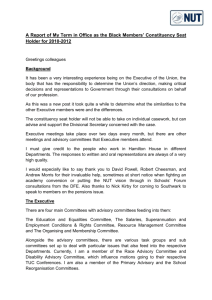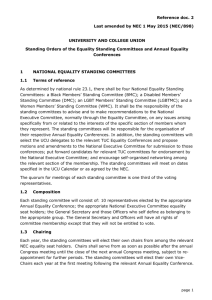
STRUCTURAL CHANGE
GENDER IN RESEARCH
GENDER AND CITIES
GENDER AND TRANSPORT
GENDER AND CLIMATE
INNOVATION IN INDUSTRY
Gender,
Science, Technology
and Environment.
A COST policy-driven network
www.genderste.eu
Inés Sánchez de Madariaga, Chair
Supporting EC policy on Gender and Science
1. Communication on the European Research Area 2012:
Gender is one of 5 priorities:
“Gender equality and gender mainstreaming in research: Encouraging gender diversity to
foster science excellence and relevance”.
Member states are invited to:
•
Create a legal and policy environment and provide incentives.
•
Engage in partnerships with funding agencies, research organizations and universities
to foster cultural and institutional change on gender.
•
Ensure that at least 40% of the under-represented sex participate in committees
involved in recruitment/career progression and in establishing and evaluating
research programs.
2. Horizon 2020 (research funding program):
•
•
•
Structural change for ensuring equal opportunities and promoting women’s careers.
Promoting integration of gender dimensions in research and innovation content
Balanced participation of women and men; gender expertise
3. Recommendation on Gender and Science, expected end 2014
Countries in progress
Countries having signed the MoU
Working Groups
• WG 1. Structural Change of research institutions: Disseminating
existing know how
• WG2. Gender in research and innovation content: Disseminating
existing know-how (Gendered Innovations Project)
• WG3. Gender in environment related areas of H2020: Mapping the
state of the art and proposing future research
•
SWG1. Cities: Developing research proposals
•
SWG2. Transport: Developing indicators to improve data
collection
•
SWG3. Energy and Climate Change: Developing a research
agenda, build links North-Shouth perspectives
• Task Force. Innovation in Industry: Identifying new markets
Expert Report Structural Change, EC 2011
•
•
Identifies problems
Indicates prerequisites for change
–
–
–
•
Proposes solutions
–
–
–
–
–
•
•
Know the institution (data)
Expertise & capacity building
Ensuring top level support
Making decision-making transparent.
Removing unconscious bias from institutional practices.
Promoting excellence through diversity.
Improving research by integrating gender analysis.
Modernizing human resources management and the
working environment by integrating gender dimensions.
Provides best international practices
Provides roadmap for action addressing:
institutions, member states, European-wide
organizations, gatekeepers of scientific excellence,
European Commission.
Contents
1. Problems faced by research institutions
2. Essential elements of structural change
3. Solutions: Bringing about structural change
4. Gender Equality Strategy: Key steps for actors at the
EU, national and institutional level
5. International Examples of Best Practice
Problems identified
1. Opaqueness in decision-making processes
2. Institutional practices inhibiting career
opportunities
3. Employment policies and practices -barriers
4. Unconscious bias in assessing excellence
5. Wasted opportunities and cognitive errors in
knowledge, technology and innovation
Prerrequisites for Structural Change (SCh)
1. Knowing the institution
2. Securing top-level support
3. Generating effective management practices
Recommendations for SCh
1. Making decision-making transparent
2. Removing unconscious bias from
institutional practices
3. Promoting excellence through diversity
4. Improving research by integrating a gender
perspective
5. Modernising human resources management
and the working environment
Recommendations to universities and scientific institutions
Ensure gender dimension is integrated into the undergraduate and postgraduate curricula, across the
university (particularly in engineering and science – e.g. Stanford University)
Adopt an Equality Plan, and include audit results (gender disaggregated statistics) in annual reports. These
should include gender pay gap, staff statistics and senior committee membership
Sign up to and follow a set of good practices (e.g. genSET recommendations):
•
gender proofing of important policy documents
•
gender impact assessment of policies and practices
•
train staff on gender dimension in research and introduce regular staff assessment (e.g. see Box 4.4 on University of Tromsø)
•
mentoring, networking, role models
•
Code of Conduct for developing early researcher standards
•
set up gender equality unit (on a high hierarchical level); centre of expertise for women and science
•
gender balance in committees, and train men to understand the issue; leadership development in implementing gender awareness
(e.g. STRIDE)
•
work-life balance for both women and men
•
positive work environment: dignity for all, no harassment or bullying, ombudsman, training (e.g. on compulsory online training on
harassment at Stanford University)
•
fair and transparent workload balance; ensure women are not allocated all the teaching and administrative work and taking care of
students
•
fair recognition of work; ensure fair signature, giving credit where credit is due
•
mobility and contract funding conditions
•
at a minimum: data and indicators, carry out climate surveys in departments (diagnosis)
Provide up-skilling – for careers, and on the content of research
STRIDE (Science and Technology Recruiting to Improve
Diversity and Excellence Committee) – University of Michigan
There were a number of factors that inhibited the University’s success at recruiting,
largely a result of inattention and of ignorance about the effect of unconscious bias
on the outcome of the process.
Through a process of introducing senior faculty, both men and women, to the
academic theory and data on evaluation bias and on aspects of academic climate
that may feel unwelcoming or hostile, the University was able to engage a group of
senior faculty in creating an approach to recruitment that resulted in wider pools
of excellent candidates.
Department chairs were able to request surveys of climate in their departments, and
to get assistance addressing climate problems within the department.
The university reports significant progress regarding recruitment of women in science
and engineering fields, from 13% of all new hires to 28% (pre- and post-ADVANCE).
The engagement and leadership of opinion leaders among the faculty, including senior
and highly respected men, was reported as a critical element in the success of
STRIDE.
University of Tromsø (Norway)
Board of Directors adopted the genSET
recommendations in full as the guiding principles
for their gender equality work in all faculties
Focus on increasing the number of women
professors (from current 23% to 30% by 2014)
http://www2.uit.no/ikbViewer/page/nyheter/artikk
el?p_document_id=207829
CERN Tripartite Employment Conditions Forum, 2010
Reaffirm the principles of non-discrimination and equality of treatment
Strengthen diversity policy through management commitment, specific
training, examination and adaption of all procedures, practices and
composition of boards at all levels, and carry out awareness-raising
Investigate factors responsible for the low number of women in top
management, including the ‘glass ceiling’ effect and the ‘leaky
pipeline’
Establish a career mentoring programme
“...Factors responsible for a low number of women in top management,
the “glass ceiling” effect and the ‘leaky pipe’, should be investigated.
Active support should be provided for example to establish a career
mentoring programme and to participate in a European women’s
network. Participation in studies at the European level to strengthen
the career chances for women scientists should be envisaged...”
ETH Zürich (Technical University)
All hiring committees must include at least two
women
Hiring committees always include external
experts
In order to alleviate the administrative workload
of ETH’s female scientists, external female
experts are also invited to join the committees
http://www.equal.ethz.ch/publications/Gender
monitoring/index_EN
Leadership and Recognition
Pioneering Women Architects and Planners
A case study : introducing gender aware concepts in
transportation: the « mobility of care »
EU-US Gendered Innovations Project
Stanford University, EC 2011-13
Fair Shared Cities.
The Impact of Gender Planning
in Europe
Inés Sánchez de Madariaga
and Marion Roberts (eds.)
Ashgate, 2013
www.genderSTE.eu











